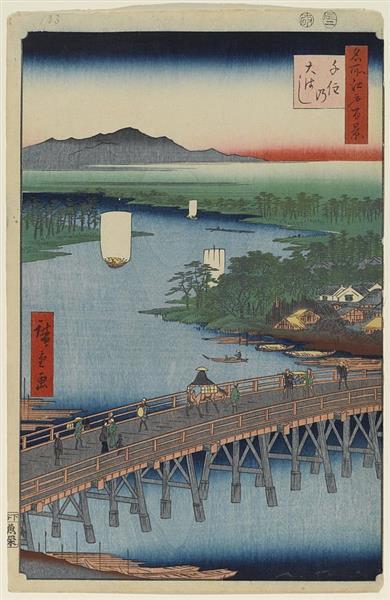Descrizione
The Senju Great Bridge, created by ukiyo-e master Utagawa Hiroshige in 1857, is set at a crucial moment in Japanese art, where a representation of the landscape that fuses natural beauty and the everyday life of Edo Japan is emerging. This woodblock print, part of the series "One Hundred Views of Edo", is an interesting exploration of the interaction between the human and natural environment, reflecting the Japanese appreciation for the landscape and its representation.
In the composition of “Great Senju Bridge,” Hiroshige uses a perspective that guides the viewer’s gaze from the foreground to the background, creating a sense of depth that invites exploration. The bridge, which extends with elegant curvature, acts as a guiding axis. To the left, several characters are in motion, carrying with them the everyday life of Japan at the time. Through these characters, Hiroshige infuses the work with a subtle, almost poetic narrative; although the characters are largely anonymous, each brings dynamism to the scene. The traditional clothing they wear reflects historical details and customs of the time, illuminating the cultural connection with the environment.
The use of color in “Great Senju Bridge” is remarkable and demonstrates Hiroshige’s mastery of the ink-printing technique. Blue hues, evoking both the clear sky and water, dominate the work, while touches of red and yellow in the clothing and surroundings break up the palette and bring energy to the composition. The shades of blue that fade towards the horizon create an atmosphere of serenity, contrasting with the activity and movement in the foreground. This use of color not only appeals to visual aesthetics, but also establishes an emotional dialogue with the viewer, inviting them to immerse themselves in the scene.
An interesting aspect to consider about this work is its place in the broader context of ukiyo-e, a style of printmaking that enjoyed a boom during the Edo period. Hiroshige, along with his contemporary Hokusai, was instrumental in developing and popularizing this medium. Both artists shared an interest in capturing the visual experience of the Japanese landscape, although each did so with a particular approach. While Hokusai tended to concentrate on mountain formations and natural phenomena, Hiroshige displayed a more intimate, everyday understanding of life. This resonates in “Great Senju Bridge,” where the focus on a specific location is transformed into an evocative depiction of urban landscaping.
Furthermore, “Great Senju Bridge” captures a moment in time, not only in the artistic sense, but also in its depiction of the changing landscape of Tokyo (formerly Edo). At the time, modernization and transformation of urban infrastructure was underway, giving works like this a documentary value as well as an aesthetic one. Hiroshige not only captures the essence of a physical space, but also offers a reflection on change and memory, a recurring theme in his work.
In sum, “Great Senju Bridge” is not just a depiction of a bridge in Japan; it is a work that symbolizes the transition of the Japanese landscape at a time of cultural change. Through his attention to detail, his expert use of color and form, and the inclusion of anonymous figures that reflect everyday life, Utagawa Hiroshige invites viewers to appreciate not only the image, but also its historical and cultural context. The painting is, ultimately, a window into life in the 19th century, captured by one of the greatest masters of Japanese art.
KUADROS ©, a famous painting on your wall.
Hand-made oil painting reproductions, with the quality of professional artists and the distinctive seal of KUADROS ©.
Painting reproduction service with satisfaction guarantee. If you are not completely satisfied with the replica of your painting, we will refund 100% of your money.

